Top 10 Best Usability Testing Agencies (2026)
Learn about usability testing agencies that conduct user testing, identify usability issues, and provide actionable recommendations.

Making something feel easy is harder than it looks. You could build a great product, yet miss your mark if you haven’t watched someone try to use it. That’s why many early‑stage teams turn to a usability testing agency. These specialists recruit real users, set up tasks and scenarios, watch what happens and feed those observations back into design. The Nielsen Norman Group defines usability testing as a moderator asking a participant to perform realistic tasks while observing behaviour and listening for feedback. This approach draws out the flaws and opportunities a designer might miss. It’s about catching customers in the act so you can solve problems before scale.
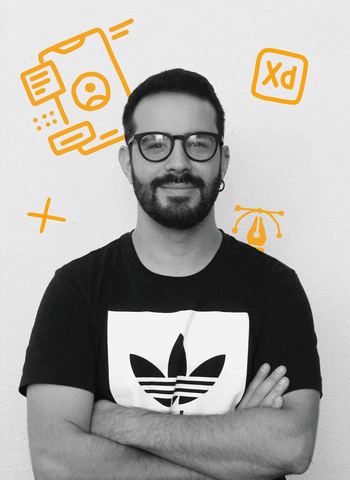
Many founders and product managers delay usability work because they think it slows things down. That’s a costly assumption. A structured sprint with user tests at the end puts real people in front of your idea in less than a week. That’s priceless for start‑ups trying to find product‑market fit the market quickly. Research also shows that half of users will abandon a site that isn’t mobile‑friendly, and 49% of businesses running usability tests plan to invest more in them next year. In short, early testing saves time, money and reputation.
The agencies in this guide were selected based on several criteria: depth of user research, mix of moderated and unmoderated methods, transparency in pricing, industry focus (e.g., fintech vs SaaS) and the ability to provide actionable insights. I also looked for teams that know how to work with small, fast‑moving product groups. After hundreds of hours inside design sprints and client workshops, certain patterns stand out. Great testing partners make recruitment painless, ask smart questions, capture both quantitative metrics and qualitative stories, and turn findings into clear next steps.
Quick Answer: Best Usability Testing Agencies for 2026
Looking for a usability testing agency in 2026? Here are 3 top picks based on different team needs:
- Parallel – Best for early-stage startups needing rapid, sprint-based testing and actionable UX insights.
- Craft Innovations – Ideal for fintech and enterprise teams seeking deep domain-specific usability research.
- UserTesting – A scalable platform solution for fast, self-serve usability testing without agency overhead.
Explore the full top 10 agency list below, with guidance on how to choose the right one based on your goals, product complexity, and budget.
What makes a great usability testing partner?
A usability testing agency isn’t just a group of testers; it’s a partner in product thinking. The work spans several overlapping areas—user experience (UX) testing, software evaluation, interface assessment, product testing, usability analysis, customer feedback and digital product testing (we’ll avoid overusing that last word but it’s about evaluating interactive experiences). A solid agency knows when to run moderated sessions (where a facilitator guides a participant), and when unmoderated tasks suffice. It can operate remotely or in‑person, explore broad discovery questions or make comparative A/B decisions. Above all, it helps your team watch the right people do the right tasks in a realistic environment.
The core elements of any usability study are simple: a facilitator, the tasks and the participants. The facilitator guides the participant through realistic activities, listens and follows up without leading. Tasks are framed as real‑world scenarios rather than test questions. Participants should match your target user group and are often asked to think aloud. Good agencies complement these elements with clear metrics: success rates, time on task, error counts and subjective satisfaction interaction-design.org. They also look for qualitative signals like facial reactions and stress interaction-design.org. Afterward they organise the data, identify key issues, rank them by severity and provide recommendations.
A mature testing partner will offer a variety of methodologies. Moderated interviews uncover why people behave as they do. Unmoderated remote tests reach larger samples quickly and cheaply, though they miss off‑screen cues. Comparative tests pit two designs against each other to pick a winner, while exploratory tests surface fresh ideas. Pricing should be transparent—some agencies charge by project or hour, others offer subscription models. Industry focus matters: a fintech app with heavy dashboards needs different methods than a consumer social app. Finally, look for actionable reporting. It’s one thing to watch users struggle; it’s another to translate that into specific design changes.
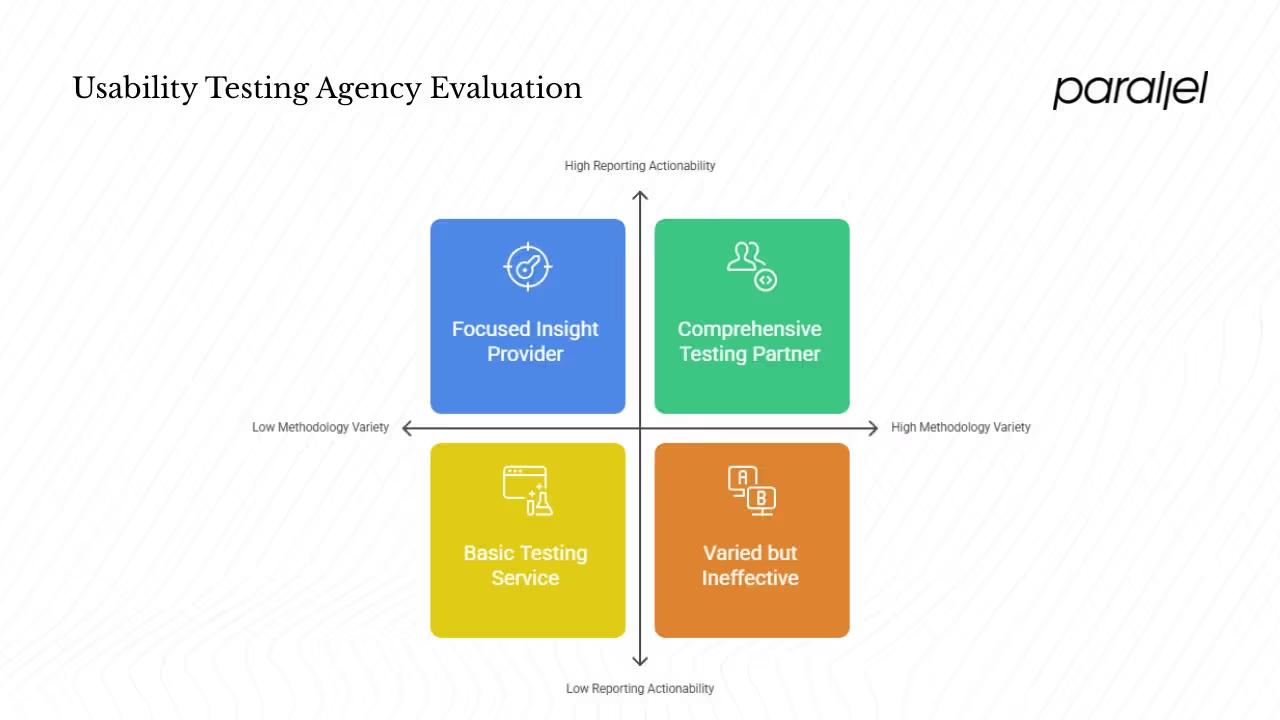
What are the top 10 usability testing agencies?
The following firms and tools cover a broad range of needs, from hands-on design partners to scalable platforms. They are listed with a short description, their strengths and why they stand out.
1. Parallel – sprint‑driven research for fast‑moving teams
As the founder of Parallel, I can tell you we aren't a traditional usability testing agency. We are a product design and strategy studio that embeds research directly inside our design sprints. Our process condenses discovery, ideation, prototyping, and testing into a single week. Day 5 of the sprint is devoted to testing a high-fidelity prototype with real users and producing a report with issues and suggestions for improvement. The sprint delivers a clickable prototype, recordings of actual users, and clear advice on what to change next. After the sprint, we run iteration cycles to improve visual design and complete the overall user experience.
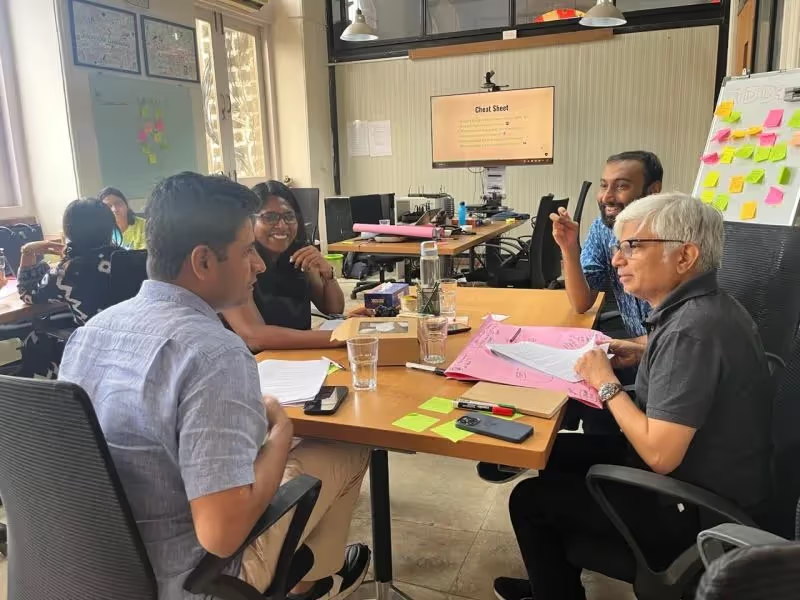
On our design sprint page, we point out that 95% of new products fail and that testing ideas with real users before investing heavily is a proven way to avoid joining that statistic. My firm has facilitated more than 50 sprints across various domains, and our team is trained by Jake Knapp, the creator of Google’s Design Sprint. We have used sprints to improve onboarding for high-growth products, launch new products, and rethink existing ones. We also run a specific design sprint for teams working with machine learning; it combines problem framing, concept development, solution evaluation, and an ethics check. This mix of hands-on design work and rigorous testing makes Parallel stand out for founders who want rapid, evidence-based progress.
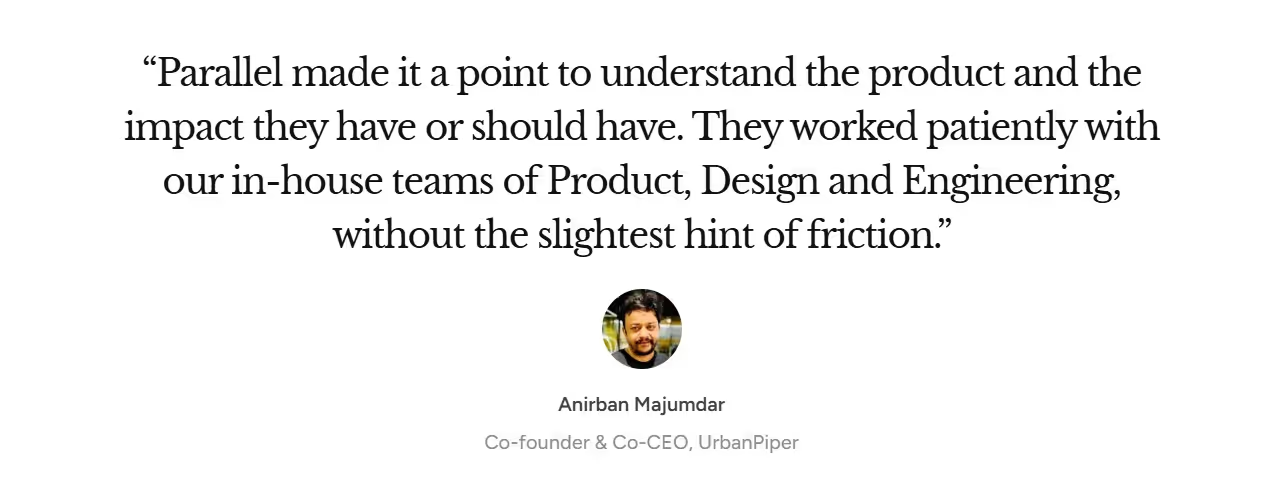
2. Craft Innovations – research‑first experts for fintech
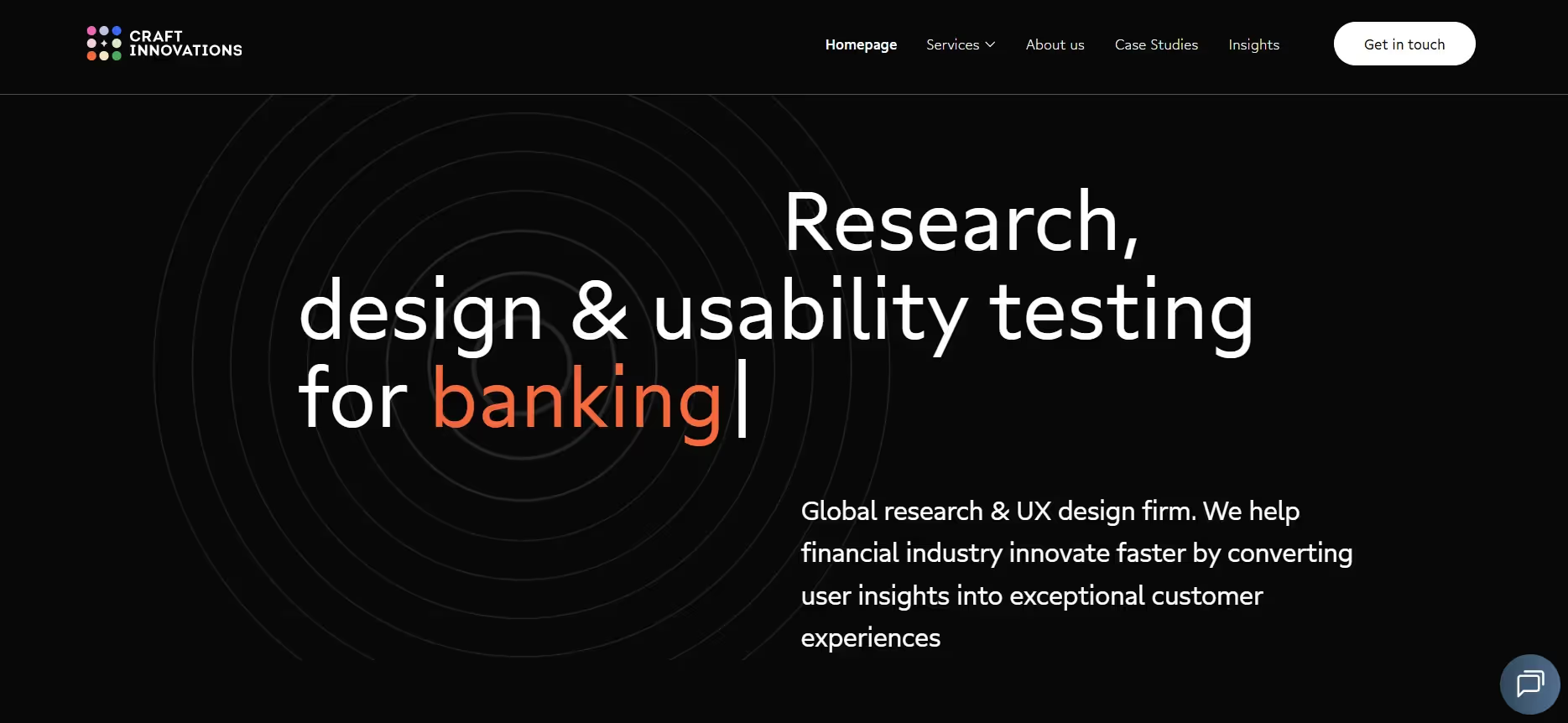
Craft Innovations is a global research and UX firm focused on the financial sector. Instead of generic lab studies, this usability testing agency offers deep research and testing that “goes beyond the numbers. Their prototype testing service uses moderated and unmoderated sessions to validate information architecture and key user flows on both low‑ and high‑fidelity prototypes. Product testing combines core user scenarios, visual concepts, UI elements and copy with follow‑up interviews to uncover causal relationships. For trading platforms and heavy dashboards, Craft Innovations employs eye‑tracking technology to analyse where users focus their gaze and how they navigate.
The firm specialises in fintech domains—retail banking, premium segments, SME/corporate banking and products like mortgages, insurance and trading. Its process covers the entire cycle: they design a testing strategy, recruit and screen target users, create tailored guides, facilitate sessions, analyse results and deliver ranked issues with severity, frequency and business impact. Deliverables include full session recordings and transcripts, heatmaps and annotated screenshots. If you’re a fintech start-up seeking a usability testing agency, Craft Innovations’ domain expertise and eye‑tracking capabilities could save you from building an interface that confuses high‑value customers.
3. Slide UX – seasoned partner for complex domains
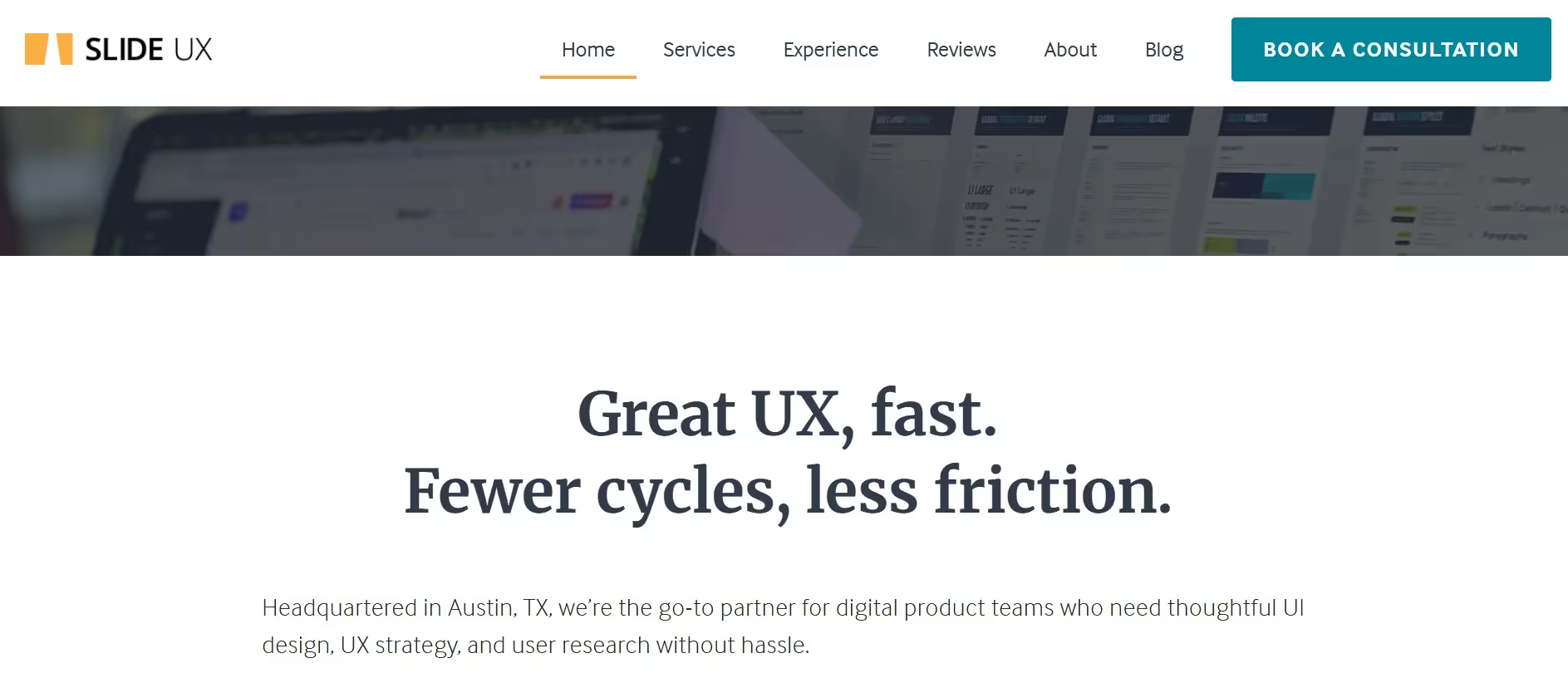
Slide UX, headquartered in Austin, Texas, positions itself as the go‑to partner for digital product teams that need UI design, UX strategy and user research. With over a decade of experience working in complex domains, this usability testing agency prides itself on efficiency and flexibility. They emphasise saving clients time and money through a lean approach and are consistently named among the world’s top UX agencies based on client feedback. Slide UX blends user research, interface design and product strategy, making it a strong option for SaaS or enterprise teams that lack in‑house expertise but still need thoughtful guidance.
4. UserTesting – scalable insight for teams of all sizes
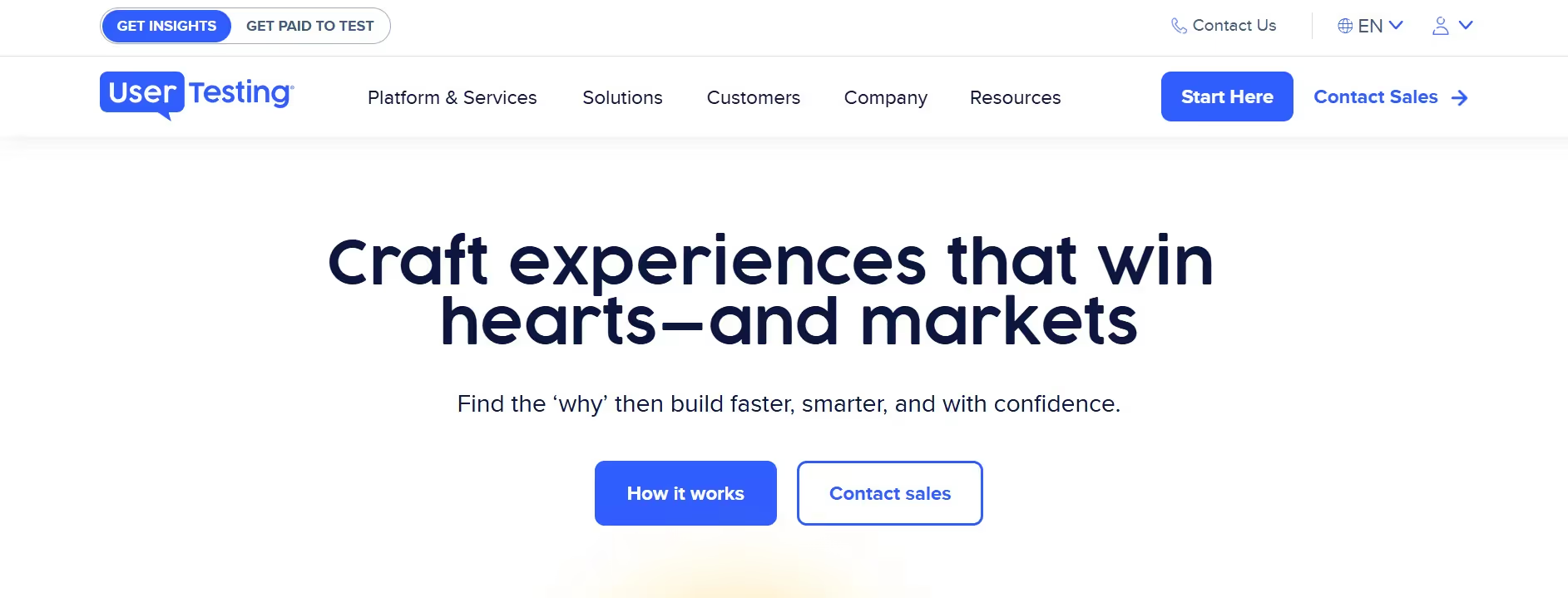
UserTesting is more platform than agency, but it earns a spot because many early‑stage teams need a scalable way to watch users quickly. The company’s “Human Insight Platform” lets you “see, hear and understand real people as they react to your concepts and designs or engage with your products” usertesting.com. It offers templates that make it easy to get fast feedback on a website, prototype, design or more. You can “target any audience” by tapping the UserTesting network or your own contacts and choose your sample size while the platform handles logistics usertesting.com. AI‑powered analytics then help you “analyze, understand and measure” key insights, visualising data to speed up post‑test analysis usertesting.com.
This usability testing agency substitute is great for concept validation, live site testing and content reviews when you don’t have a dedicated research team. Pricing isn’t publicly listed, but reviews suggest flexible subscription tiers with free trials and entry plans accessible to small teams. If you need to gather quick feedback without a consultancy overhead, UserTesting offers a self‑serve way to do so.
5. Maze – rapid feedback and continuous discovery
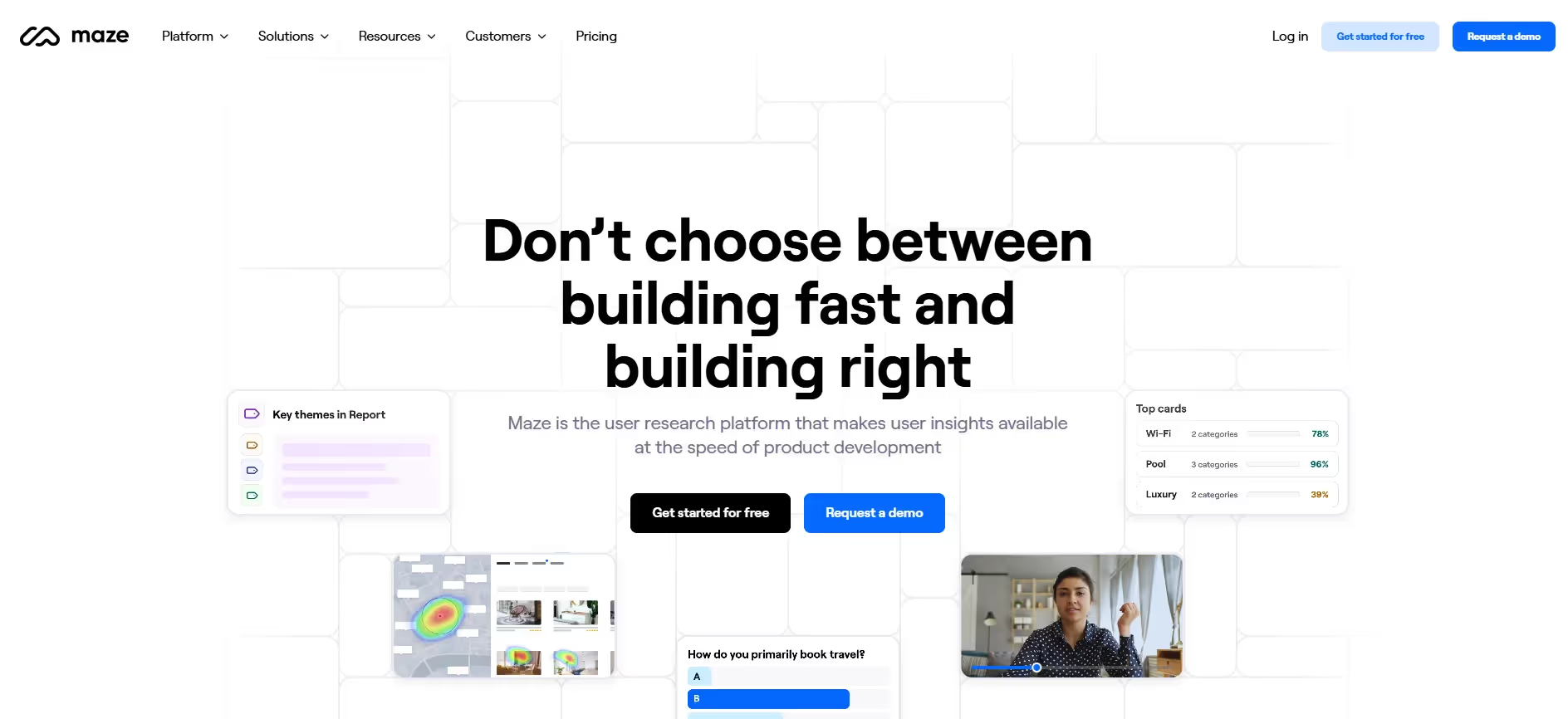
Maze is a product discovery platform that positions itself as an alternative to traditional usability testing agency services. Its meta description summarises the offering: run user interviews, usability tests and surveys at the speed of product development. Maze supports remote unmoderated usability testing, allowing participants to complete tasks on their own schedule using high‑fidelity prototypes. This approach lowers cost and broadens your tester pool, though you sacrifice some context because you can’t watch body language. The platform also includes AI‑powered interview studies for moderated research and custom reports to keep insights in one place.
Maze’s business model makes it attractive to cash‑strapped start‑ups: the Capterra listing describes it as a continuous product discovery platform that lets teams create and send usability tests quickly, with a starting price of $75 per user per month and a free trial capterra.com. If you’re already working in Figma or Sketch, Maze integrates directly and lets you iterate prototypes without booking external sessions. That said, it may not replace a full‑service usability testing agency when you need deeper interviews or complex recruitment.
6. Global App Testing – international reach on real devices
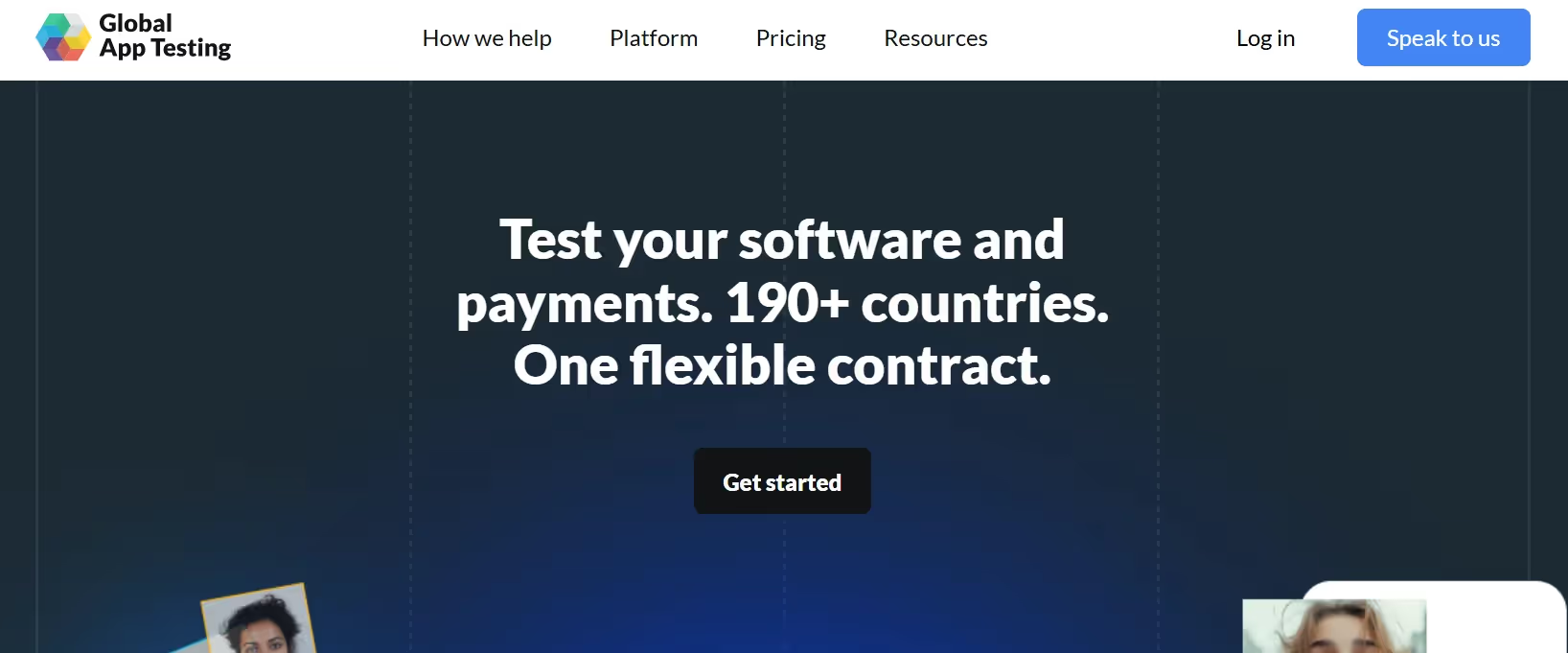
Global App Testing is more than a usability testing agency; it’s a QA and research company that can build a UX programme you can scale worldwide. Their UX and usability testing service promises to deliver results in 48 hours, drawing from a pool of testers in 190 + countries globalapptesting.com. Teams can run tests on real devices and collect direct survey responses from professionals across the globe globalapptesting.com. This makes it possible to validate flows on a wide range of devices and customer profiles, which is crucial for consumer apps or products with global ambitions. The company markets a “scalable approach” that lets you start small and ramp up as you expand globalapptesting.com.
7. Widelab – design and research with development chops
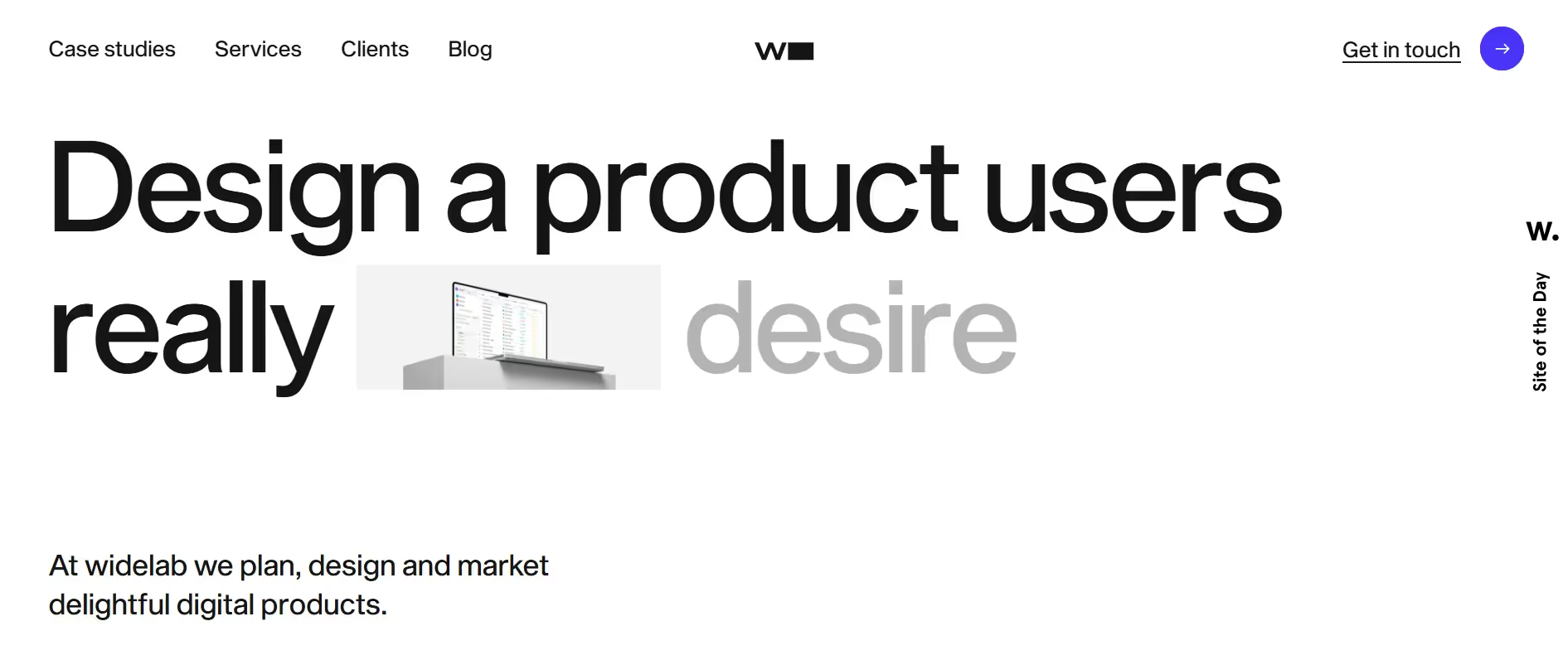
Widelab is a Poland‑based agency that plans, designs and markets digital products. Their website notes that they’ve completed over 300 projects, with services ranging from product design and UI/UX design systems to prototypes, strategy, branding and Webflow development. According to a 2024 review on Eleken’s blog, Widelab helps products look sharp and work better through branding, design and development focused on user interfaces; clients have collectively raised $110.8 billion. Reviewers praise their flexibility and business‑oriented designs but caution that research stages can take longer than expected. Widelab is a solid choice if you need a usability testing agency that also owns visual design and front‑end development.
8. Meticulous – your outsourced UX department
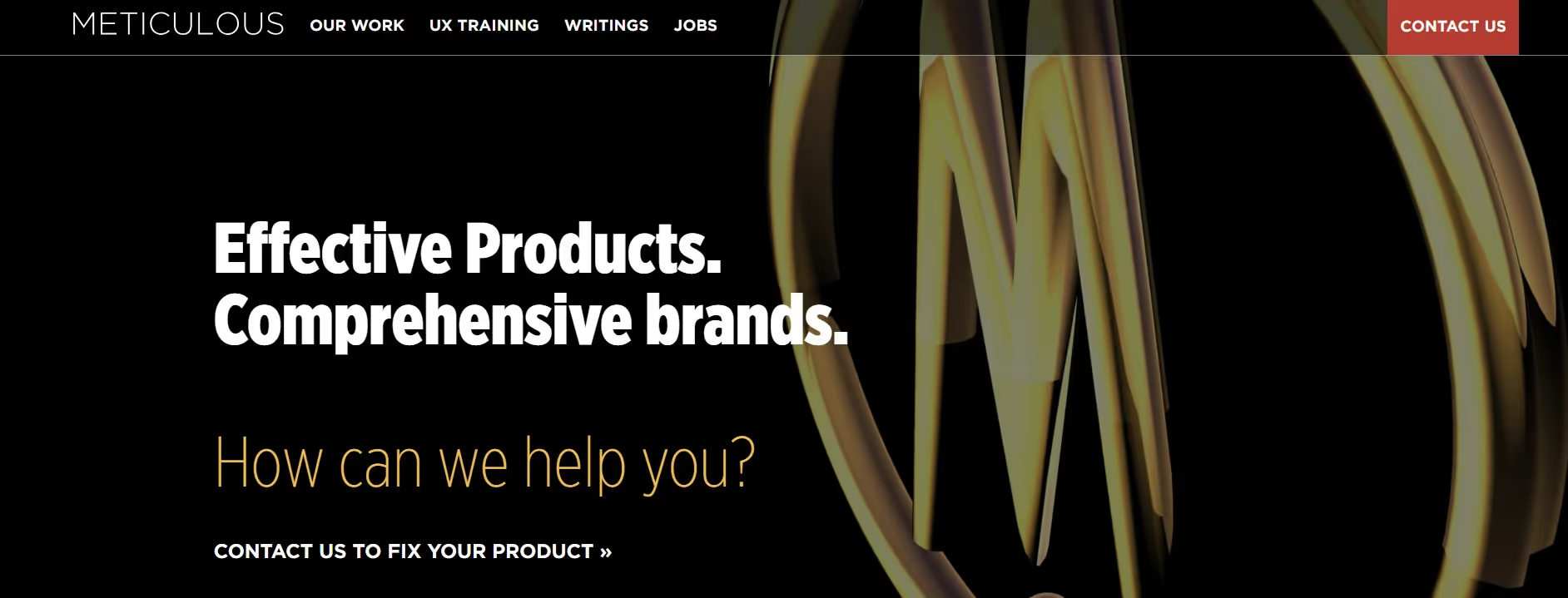
Meticulous calls itself a boutique UX studio that acts as “a UX department for companies who don’t have full‑time designers.” The firm offers microsprints, design accelerators and UX design subscriptions, building an enterprise‑grade product design foundation. They focus on producing user‑validated designs that help teams optimise software and reach their goals. If you’re building internal tools or custom software, this usability testing agency can embed with your team and run the research and design work your engineers don’t have time for.
9. TestMatick – QA specialists with usability expertise

TestMatick is a software testing company founded in 2009. Headquartered in the United States with branches across Europe, it employs over 150 QA engineers and offers more than 20 types of QA services. While primarily known for automated and manual QA, TestMatick also provides usability testing as part of its suite. Their mission is to solve business problems through high‑quality software testing, and their scale makes them a reliable partner when you need a usability testing agency that can also handle performance and security tests under one roof.
10. QualityLogic – technical QA with a human touch
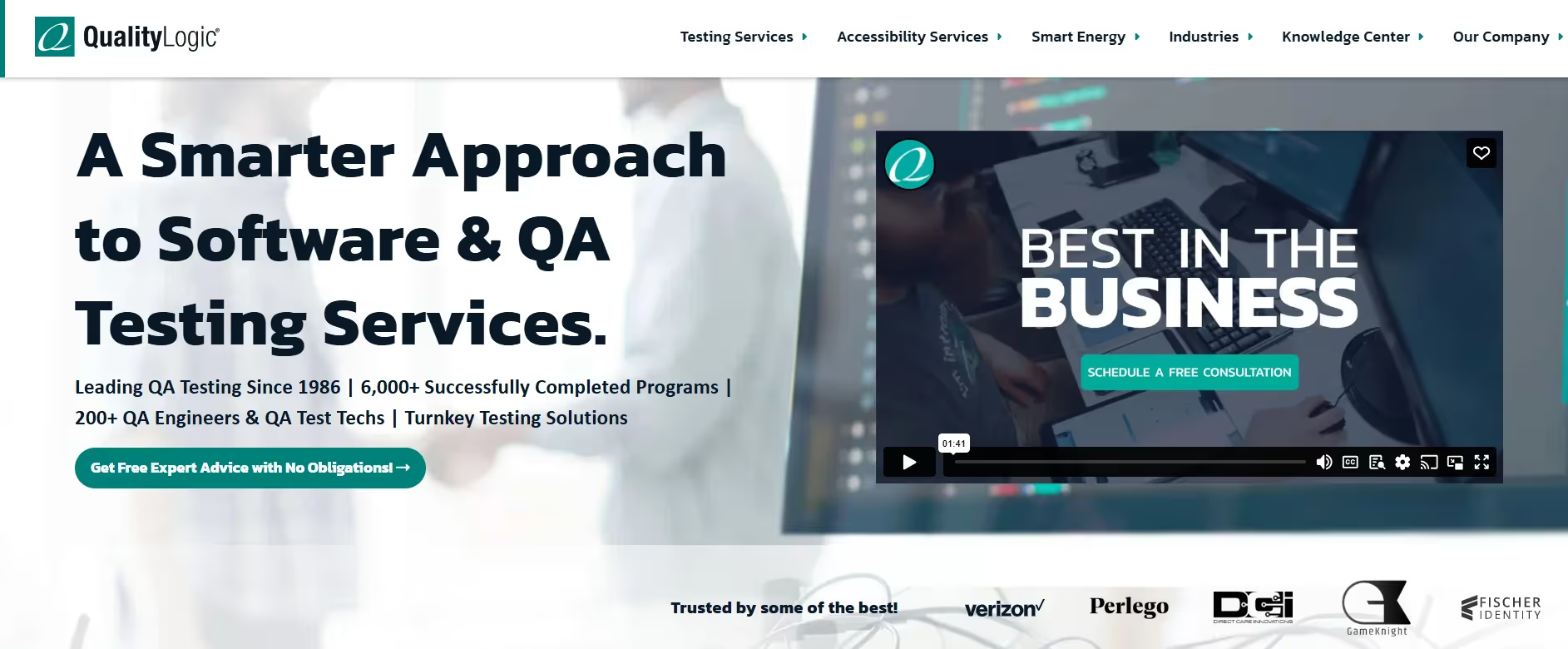
QualityLogic is a U.S.‑based testing firm that emphasises the importance of actual user interaction. Its usability testing page states that “there’s no substitute for usability testing” and that experienced technicians verify interface operations. They ensure that each control does what the user expects and that UI elements are placed logically. In other words, they treat the interface like a conversation between the product and the user rather than a checklist. QualityLogic’s broad QA background and pragmatic outlook make it a good fit when you need a usability testing agency to work alongside functional testers.



.avif)










